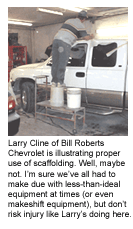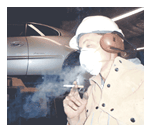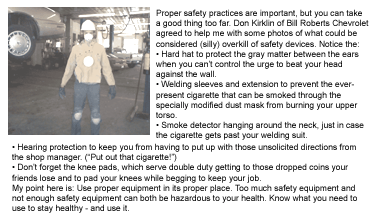Don’t run with scissors, don’t cross your eyes or they’ll stick, don’t touch your tongue to a flagpole when it’s cold … Don’t, don’t, don’t, don’t, don’t, don’t!
Just try to count the times you’ve heard don’t do this or don’t do that. It gets to a point where there are so many “don’ts” that a person begins to dismiss them as frivolous ravings. After all, you never went blind, despite the numerous warnings given to you by your grandmother.

Keep in mind, however, that some of the warnings we’ve received over the years actually do have a little merit – especially the ones concerning our profession.
I think it was Mickey Mantle who said, “If I’d known I was going to live this long, I’d have taken better care of myself.” As clever as that sounds, you’re better off taking care of yourself now; it’s much easier to prevent unnecessary contaminants in your body than it is to repair the damage they can cause.
Who Am I?
Let me give you a brief synopsis about my qualifications to talk about safety. At 18 months old, I had my first bad experience with hazardous material. I ingested enough Drano to land me in the hospital for a good while, leaving me with some ever-present scars.
I’m not sure if Sis thought she needed to feed her hungry baby brother or if I thought I should eat the colorful morsels before Sis beat me to it, but I realize now that eating Drano is considered an “unsafe” thing to do. If only I’d studied reading earlier so I could have read those warnings on the label.
My life was pretty much uneventful for a few months after that – up until I stuck some old keys with a metal keychain around my hand and into an electrical socket. It was becoming evident that I wasn’t a quick learner.
Still, years went by … until the next couple of episodes involving my fascination with fire. It wasn’t really a big thing, and I don’t know why Mom keeps bringing it up, but the garage and the bathroom ended up with such minor damage that I don’t see how it’s hardly worth mentioning here. Although Mom didn’t believe that bad wiring and a gas leak in the bathroom caused such a fire, it seemed perfectly feasible to a 7-year-old trying to talk his way out of trouble.
My next memorable bump happened at about the age of 8, as I sat one Saturday morning on a footstool watching cartoons. I was totally oblivious to my brother swinging a ball bat in the house (he did it constantly), and I really didn’t notice that with each swing, he unknowingly stepped a little closer to me. POW!
I was unable to see that eye (nor could anyone else) for a really long time.
After that incident, I did really well for what seemed like an eternity. It wasn’t until I was nearing 13 years old that I ran along a barbed wire fence with my motorcycle. It was Mother’s Day, and the good news is, we did get to spend the day together – although most of it was at the hospital while I received in excess of 200 stitches.
We won’t talk about the things that happened during my adult years. You know, after 13. We just don’t have that kind of time.
Needless to say, my guardian angel received top honors for the challenges she faced after being assigned to me. My point here is that these examples should be enough to illustrate my qualifications when discussing safety. After all, would you go to a doctor who’s never been sick or listen to a preacher who’s never sinned?

Warnings Exist for a Reason
Following safety warnings isn’t as fun as watching
Homer Simpson set himself on fire or one of the Three Stooges step on a rake and then smack his face with the handle, but personally, I don’t enjoy such pain anymore.
We’ve all had safety warnings drilled into our heads, yet we don’t have to look far to see how often these warnings are ignored – partially or even completely.
I’ve witnessed such ludicrousness as cutting holes in dust masks so the technician can still smoke while being “safe.” Another cute trick I’ve witnessed: a well-intentioned safety fanatic taping a paint strainer to his face because he was out of dust masks. It’s real hard to keep a straight face when a shop foreman wearing a paint strainer is scolding you for ignoring safety regulations.
I have to admit that, at times, I, too, have been a little lax with precautions. But I do realize that, invariably, we’ll all live longer, healthier lives if we practice better safety procedures.
How many of us, when in a hurry, have thought that it just wasn’t worth finding where we left our mask just to “spray a little spot”? But is being in a hurry worth your health? It’s like the guy who said he was able to cut his smoking in half after losing one of his lungs.
I keep going on as if masks are the only safety item we have to worry about, but we all know that protecting the air we breath is just the tip of the iceberg.
Working in a small dealership environment, I often feel that we’re teetering on the edge between being big enough that everyone is watching to small enough that no one is going to care what we do.
I do feel fortunate that Marlin Parrott Sr., a loss control specialist from one of the insurance companies, comes around periodically to check us out and give us reminders of ways we can be safer.
I’ll be the first to admit that it’s hard for me to define just how safe is safe enough. For instance, Marlin was in doing one of those periodic inspections that we’re actually fortunate to have, and he noticed one of my technicians buffing a hood on a car. Marlin asked me where his safety glasses were, and I jokingly replied that Larry has contact safety glasses, which explains why Marlin couldn’t see them.
I did get a look and a smile of sorts from Marlin, as he does have a sense of humor, but he also takes safety seriously. After the smile, he told me good try, but Larry needs to get his safety glasses on when buffing.
Well, I personally haven’t heard of anyone losing an eye from buffing, but I do see that there’s a certain amount of potential that could cause an injury, if ever so slight.
Everyone has a different perception of risk involved in every situation, and Marlin is trained to help us minimize risks. I’m not going to try to blow smoke up your skirt and make you think that we follow every rule, every day, that Marlin points out, but I will say that he’s opened my eyes more than once to things that one can take for granted.
Why I Wrote This Article
You don’t see lots of old bodymen and you have to wonder if it’s due to mortality issues (they’re all dead?) or do they just get wise and get out of the business?
The passing of an old bodyman influenced me to write this article. The man I’m speaking of was the major influence who got me interested in the auto repair business. He was also my brother, Bob Carter.
Bob died March 8th, 2003, at the age of 62. He’s missed by many, especially those of us who counted on him. Bob was always there for me, and I took for granted that he always would be. I’ve often thought that if I’d known how short Bob’s time with us would be, I would have spent more of mine with him.
Helping others is what brought Bob the most joy. He helped me and so

many others in so many ways. He educated me in repair procedures and, more importantly, in philosophies of life.
He could seemingly fix anything that anyone could damage, and let me tell you, I tested that theory many times. He taught me the basics I use every day to repair automobiles and to face life. I can’t say Bob was the best example of how to live a long, safe life, but he had fun.

Granted, using good safety practices isn’t really fun, but it can extend the length of time we have available to have fun. And who knows what would have happened if Bob would have used better safety habits. Maybe if he’d stayed away from fried foods, quit smoking and worn his mask and safety glasses, he’d have still died before we were ready to let him go. But maybe not.
Bob loved to help others. I just hope that this article helps at least one person to re-think his safety habits and to live a longer, healthier life. If it does, I think ol’ Bob would be proud.
|
Top 10 OSHA Regulation Violations
By Autobody Shops, Oct. 2002 – Sept. 2003 Respiratory Protection. OSHA Standard: 29 CFR 1910.134. Hazard Communication. OSHA Standard: 29 CFR 1910.1200. Spray Finishing with Flammable/Combustible Materials. OSHA Standard: 29 CFR 1910.107. Flammable and Combustible Liquids. OSHA Standard: 29 CFR 1910.106. Electrical, Wiring Methods, Components and Equipment. OSHA Standard: 29 CFR 1910.305. Personal Protective Equipment, General Requirements. OSHA Standard: 29 CFR 1910.132. Electrical Systems Design, General Requirements. OSHA Standard: 29 CFR 1910.303. Air Contaminants. OSHA Standard: 29 CFR 1910.1000 Medical Services and First Aid. OSHA Standard: 29 CFR 1910.151 Abrasive Wheel Machinery. OSHA Standard: 29 CFR 1910.215. Twenty-six states have their own OSHA programs. These OSHA-approved State Plan programs have standards that are “at least as effective as” Federal OSHA standards. State plans provide To view violations and descriptions of the OSHA standards, go to http://www.osha.gov/SLTC/autobody/standards.html. |
Contributing editor Keith Combs is the body shop manager at Bill Roberts Chevrolet, where he’s been employed for 25 years. He was named GM/ASE Master Collision Repair/Refinish Technician of the year 2000 and was one of the first to achieve GM’s World Class Technician status in 2002.













